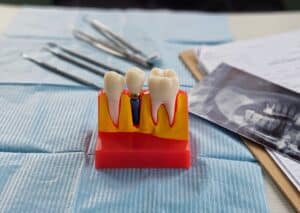For Many People, the Answer is Definitely Yes
With the hundreds of products available on the market today for cleaning your teeth, it can be difficult for dental patients to determine which product will best meet their needs. The dentists at Personal Care Dentistry are happy to assist patients in choosing the appropriate products for cleaning their teeth, as every smile is different.
Among the many types of toothbrushes available, the general categories are manual and electric toothbrushes. However, a more unique solution for cleaning your teeth at home can be found with a water pick.
How does a water pick work?
A water pick is also sometimes referred to as a water flosser. Water picks work by using water to irrigate the spaces between your teeth and powerfully blast away debris from other hard to reach places. A water pick works to mimic the high pressure water cleaning that your dentist uses to prepare your teeth for procedures or to rinse them during professional cleanings.
Is using a water pick the same as brushing?
It is important to know that using a water pick is not a substitute for brushing and flossing your teeth. Over time plaque builds up on the surface of your teeth. This plaque harbors bacteria and germs that can lead to bad breath, gum disease and tooth decay.
When you use a water pick, you’re not only dislodging any particles or debris and bacteria you might have missed when brushing, you are also gently massaging the gums, which helps promote blood flow in the gums and keeps them healthy. While water picks are an excellent addition to your daily fight against gingivitis and other periodontal diseases, they are incapable of fully removing plaque, which is why the dentists at Personal Care Dentistry want to remind you to keep brushing and flossing every day.
Is using a water pick the same as flossing?
While water picks work to provide extra cleaning power for your smile, it is important to know that they do not ever take the place of brushing or flossing. Despite the nickname water flosser, water picks do not get completely in between each of your teeth. Water picks may not be an effective solution for cleaning between teeth that are crooked, overlapping or tightly spaced. Floss is the only guaranteed way to eliminate debris from between your teeth.
What are the advantages to using a water pick?
People with painful gum disease or highly sensitive gums may find water picks useful or even therapeutic. However the use of a water pick is only advised as a supplement to regular brushing and flossing, especially in patients with advanced gum disease.
Orthodontic patients, especially those with traditional metal braces may find added benefit from using a water pick to flush out hard to reach places within their wires and brackets.
If you are considering adding a water pick to your daily at home dental care routine it is important to understand that these devices do not replace traditional brushing and flossing.
So how do you choose the right water pick?
Water picks are available for home or portable use. The home versions tend to be larger and use standard electrical outlets, while portable models use batteries. Aside from the size difference, they work in the same manner, both using pulsating water streams. A more crucial difference between water picks is the ability to adjust the pressure. Most home models will let you choose from several pressure settings, depending on how sensitive your teeth and gums are. Most portable models have only one pressure setting. If you want to use mouthwash or a dental rinse in your water pick, check the label first; some models suggest using water only.
If you’d like more information about how to best care for your teeth at home, including information about water picks at home, contact Personal Care Dentistry today.
.


